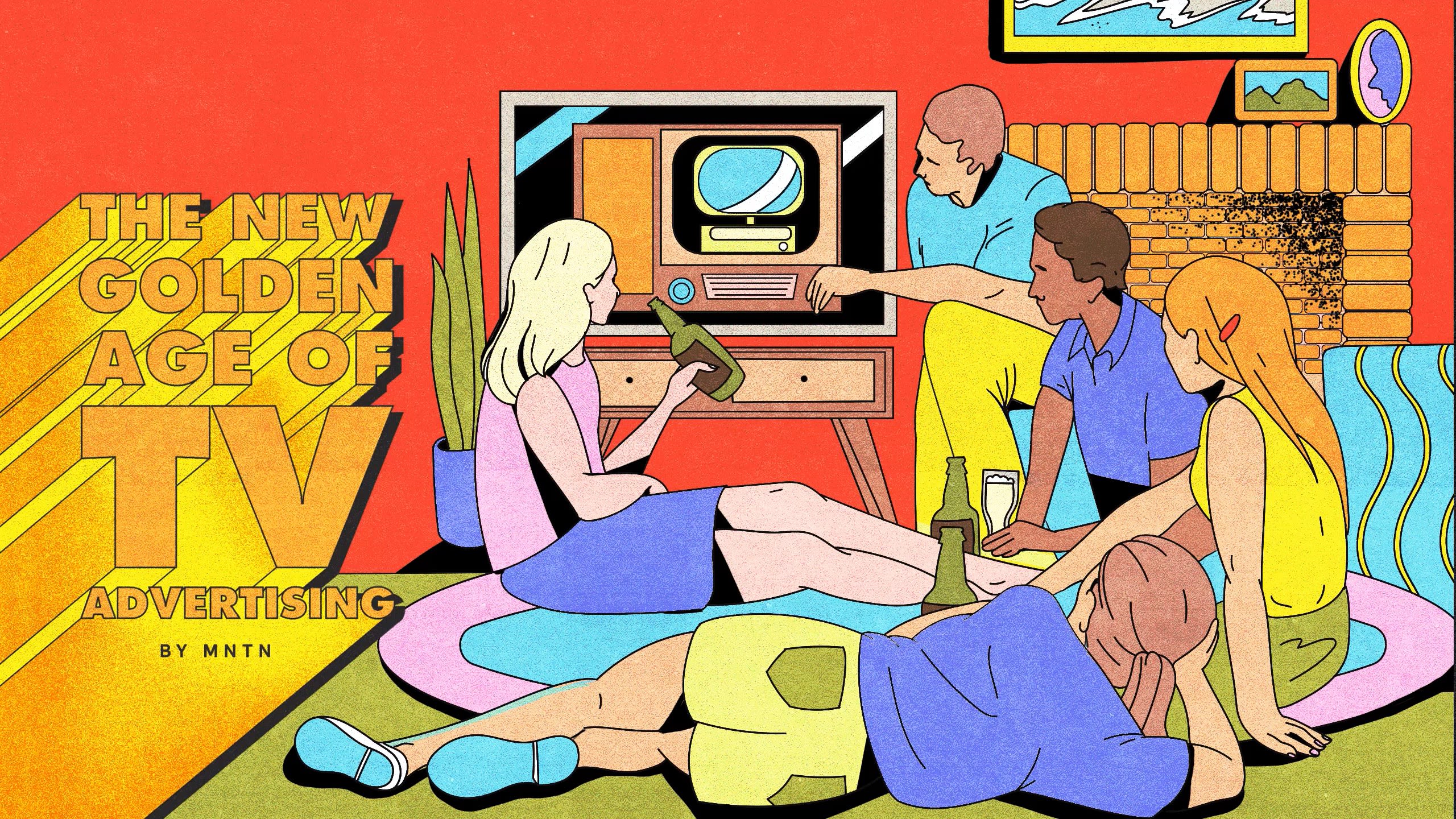
Television loves risk takers and envelope pushers. Early audiences were thrilled by live broadcasts—think Your Show of Shows and Playhouse 90. Was that the Golden Age? Or maybe the real Golden Age was the so-called Peak TV that started with The Sopranos and The Wire and rode into Mad Men and Breaking Bad. Every era redefined cutting edge.
TV ads have had their own Golden Age. Coca-Cola’s “I’d Like to Buy the World a Coke,” released against the backdrop of Vietnam protests and national divisions, celebrated diversity and bridging divides. Are we surprised consumers sent over 100,000 fan letters to the brand and called radio stations to request the jingle?
Ditto for Budweiser’s “Wassup,” which, in less than 10 words, epitomized male friendship. And Old Spice’s hilarious campaign, “The Man Your Man Could Smell Like,” turned marketing doctrine on its head by selling men’s cologne to women.
Today, the industry is in the middle of a transformation, but with an important twist: It’s digital.
In yesterday’s Golden Age, viewers had to wait a week for the next episode. But now, connected TV (CTV) gives consumers the freedom to binge-watch entire seasons at a time.
Advertising is in lockstep with the technology, letting brands experiment with creative geared toward specific audiences and measure the impact of their ad spend. Thankfully, the era of 18-34 demographics and GRPs is over. CTV ad spend is projected to expand 39% in 2022, hitting $21.2 billion—more than double than in 2020.
CTV is a golden opportunity for brands to create highly innovative content in response to cultural moments and effectively measure results (think of the 2013 Oreo tweet, “You can still dunk in the dark” when the Super Bowl stadium lights went out, but for TV).
Brands that want to stay relevant will need to update their approach to advertising on TV. By eschewing the big upfront buys and cinematic-like production, CTV is democratizing television advertising. Let’s look at TV’s new rules.


Television loves risk takers and envelope pushers. Early audiences were thrilled by live broadcasts—think Your Show of Shows and Playhouse 90. Was that the Golden Age? Or maybe the real Golden Age was the so-called Peak TV that started with The Sopranos and The Wire and rode into Mad Men and Breaking Bad. Every era redefined cutting edge.
TV ads have had their own Golden Age. Coca-Cola’s “I’d Like to Buy the World a Coke,” released against the backdrop of Vietnam protests and national divisions, celebrated diversity and bridging divides. Are we surprised consumers sent over 100,000 fan letters to the brand and called radio stations to request the jingle?
Ditto for Budweiser’s “Wassup,” which, in less than 10 words, epitomized male friendship. And Old Spice’s hilarious campaign, “The Man Your Man Could Smell Like,” turned marketing doctrine on its head by selling men’s cologne to women.
Today, the industry is in the middle of a transformation, but with an important twist: It’s digital.
In yesterday’s Golden Age, viewers had to wait a week for the next episode. But now, connected TV (CTV) gives consumers the freedom to binge-watch entire seasons at a time.
Advertising is in lockstep with the technology, letting brands experiment with creative geared toward specific audiences and measure the impact of their ad spend. Thankfully, the era of 18-34 demographics and GRPs is over. CTV ad spend is projected to expand 39% in 2022, hitting $21.2 billion—more than double than in 2020.
CTV is a golden opportunity for brands to create highly innovative content in response to cultural moments and effectively measure results (think of the 2013 Oreo tweet, “You can still dunk in the dark” when the Super Bowl stadium lights went out, but for TV).
Brands that want to stay relevant will need to update their approach to advertising on TV. By eschewing the big upfront buys and cinematic-like production, CTV is democratizing television advertising. Let’s look at TV’s new rules.

Don’t be intimidated by TV’s reputation as a pricey medium. Sure, Philip Morris spent $8 million to sponsor I Love Lucy back in 1953 (about $86 million today), and yes, brands continue to spend millions producing and procuring their Super Bowl spots. While those ads are geared for the masses, CTV campaigns can be used for both mass reach as well as reaching highly targeted audiences.
Effective TV advertising is a matter of flexibility and a streamlined approach to creative production so that brands can customize their messages to a specific audience, measure the impact and iterate.
Back in the day, television advertising was a bit spray-and-pray. Philip Morris hoped smokers tuned in to “I Love Lucy,” but it was under no illusion that the show’s entire audience lit up. Showing ads to people who would never convert was a fact of life.
This contrasts with CTV, which allows brands to serve ads based on the audience (e.g., demographics, interests, location), not the show's content. By targeting viewers on the audience-level, advertisers can reach them as they jump from app to app, service to service, show to show. They know who sees their ads and what impact it has on audience behavior. All at once you see a lot more information and nuance.
And when advertisers know who sees their ads and who demonstrates an interest in a product, they can engage in their own episodic storytelling.
Let’s say an advertiser shows an in-stream ad for 3D printed eyeglass frames to a user who's streaming her favorite sitcom on a Smart TV. Intrigued, she visits the advertiser’s page on her smartphone and uses VR to see how different styles look on her face. After a few minutes, she refocuses her attention on the show without converting. Later, the brand can re-message her with ads served across web, mobile and CTV—even using a QR code in the creative to drive her to a landing page.
In fact, the brand can serve any number of interactive ads exclusively to viewers who have already visited its website—wherever they are in the digital universe.
The first rule for CTV success: Tie your creative development and ad spend to business outcomes.
If your goal is to prompt moms in the Midwest to test drive a new car model, create an ad especially for them and show that ad to them exclusively.


Don’t be intimidated by TV’s reputation as a pricey medium. Sure, Philip Morris spent $8 million to sponsor I Love Lucy back in 1953 (about $86 million today), and yes, brands continue to spend millions producing and procuring their Super Bowl spots. While those ads are geared for the masses, CTV campaigns can be used for both mass reach as well as reaching highly targeted audiences.
Effective TV advertising is a matter of flexibility and a streamlined approach to creative production so that brands can customize their messages to a specific audience, measure the impact and iterate.
Back in the day, television advertising was a bit spray-and-pray. Philip Morris hoped smokers tuned in to “I Love Lucy,” but it was under no illusion that the show’s entire audience lit up. Showing ads to people who would never convert was a fact of life.
This contrasts with CTV, which allows brands to serve ads based on the audience (e.g., demographics, interests, location), not the show's content. By targeting viewers on the audience-level, advertisers can reach them as they jump from app to app, service to service, show to show. They know who sees their ads and what impact it has on audience behavior. All at once you see a lot more information and nuance.
And when advertisers know who sees their ads and who demonstrates an interest in a product, they can engage in their own episodic storytelling.
Let’s say an advertiser shows an in-stream ad for 3D printed eyeglass frames to a user who's streaming her favorite sitcom on a Smart TV. Intrigued, she visits the advertiser’s page on her smartphone and uses VR to see how different styles look on her face. After a few minutes, she refocuses her attention on the show without converting. Later, the brand can re-message her with ads served across web, mobile and CTV—even using a QR code in the creative to drive her to a landing page.
In fact, the brand can serve any number of interactive ads exclusively to viewers who have already visited its website—wherever they are in the digital universe.
The first rule for CTV success: Tie your creative development and ad spend to business outcomes.
If your goal is to prompt moms in the Midwest to test drive a new car model, create an ad especially for them and show that ad to them exclusively.

Before the digital age, advertisers couldn’t link ad spend to consumer behavior, so they tried the next best thing: creating ads that were aired so frequently they’re ingrained in the minds of entire generations of Americans.
If you watched TV in the 1970s you knew that Mikey, who hates everything, likes Life cereal. A decade later, Wendy’s coined one of the most famous slogans of all time, “Where’s the beef?” to the amusement of TV viewers everywhere (presidential candidate Walter Mondale even used it on the campaign trail).
Those slogans are memorable, and the ad campaigns helped move the needle for the brands (Wendy’s saw a 31% increase in revenue). But brands don’t need to spend millions to get similar boosts. Rather, they need to build the best possible experience for every viewer that they reach. Experience is all about relevancy.
If you’re Wendy’s, would you want to show the “Where’s the Beef?” ad to a vegan? Of course not. And would you show that creative to the same consumer five times in a row? Not if you can help it! Ad fatigue is real, and it annoys consumers to no end.
By the way, ad fatigue is an issue in CTV as well as linear. A 2021 Conviva poll found that 59% of consumers think there are too many repeated ads on CTV.
Fortunately, it’s easy to avoid these mistakes with CTV, as precision targeting and measurable results mean advertisers know who they reach, how they respond and what the next best action to take is.
The buying experience doesn’t end when the consumer decides to purchase or pursue more information. With digital, marketers can plan the true end-to-end experience, from seeing a first ad, finding the product of interest, completing the purchase and receiving the item.
The second rule for CTV success: Adopt a strategy of creative refresh.
Make regular updates to the spots you run so your campaigns capture more audience attention and avoid an unhealthy amount of ad fatigue. Creative refreshes allow you to optimize for performance, as well as avoid alienating your audience.
You and your team can lean into performance data to identify a winning creative direction. Let’s say you run an ad featuring a set of characters with big personalities, and the campaign exceeds your goals. You now know you may have a hit and can continue to update future creative with these characters in mind. Think of it as a way to find your own Geico Gecko—the key to get viewers to pay attention.



Before the digital age, advertisers couldn’t link ad spend to consumer behavior, so they tried the next best thing: creating ads that were aired so frequently they’re ingrained in the minds of entire generations of Americans.
If you watched TV in the 1970s you knew that Mikey, who hates everything, likes Life cereal. A decade later, Wendy’s coined one of the most famous slogans of all time, “Where’s the beef?” to the amusement of TV viewers everywhere (presidential candidate Walter Mondale even used it on the campaign trail).
Those slogans are memorable, and the ad campaigns helped move the needle for the brands (Wendy’s saw a 31% increase in revenue). But brands don’t need to spend millions to get similar boosts. Rather, they need to build the best possible experience for every viewer that they reach. Experience is all about relevancy.
If you’re Wendy’s, would you want to show the “Where’s the Beef?” ad to a vegan? Of course not. And would you show that creative to the same consumer five times in a row? Not if you can help it! Ad fatigue is real, and it annoys consumers to no end.
By the way, ad fatigue is an issue in CTV as well as linear. A 2021 Conviva poll found that 59% of consumers think there are too many repeated ads on CTV.
Fortunately, it’s easy to avoid these mistakes with CTV, as precision targeting and measurable results mean advertisers know who they reach, how they respond and what the next best action to take is.
The buying experience doesn’t end when the consumer decides to purchase or pursue more information. With digital, marketers can plan the true end-to-end experience, from seeing a first ad, finding the product of interest, completing the purchase and receiving the item.
The second rule for CTV success: Adopt a strategy of creative refresh.
Make regular updates to the spots you run so your campaigns capture more audience attention and avoid an unhealthy amount of ad fatigue. Creative refreshes allow you to optimize for performance, as well as avoid alienating your audience.
You and your team can lean into performance data to identify a winning creative direction. Let’s say you run an ad featuring a set of characters with big personalities, and the campaign exceeds your goals. You now know you may have a hit and can continue to update future creative with these characters in mind. Think of it as a way to find your own Geico Gecko—the key to get viewers to pay attention.

Here’s the real magic of CTV: It’s not just about raising brand awareness. The ability to measure results and optimize on specific KPIs means television has morphed into a powerful vehicle for performance campaigns.
In the past, TV campaigns were based on hope: A brand hoped its target audience tuned into the program in which its ads appeared and hoped the viewers who saw it took a desired action.
To measure the efficacy of linear TV campaigns, the industry deployed a range of probabilistic strategies, such as focus groups and consumer surveys, often over the course of several years. It was a slow, tedious and inexact process.
On the other hand, CTV allows advertisers to track the direct outcomes driven by their campaigns in real time. Was the ad shown to the advertiser’s target audience, and their target audience only? Did some creatives prompt more responses than others? It’s even possible to ask the viewer for feedback at the end of the ad by presenting them a survey.
CTV also eliminates speculation. Marketers can launch, track and optimize their campaigns (and results) based on KPIs that matter most. How many orders were placed? How many dormant customers reactivated their service as a result of seeing the ads? With the right tracking and platforms, marketers can calculate the impact of their ad spend on their bottom lines—in real time.
Marketers can also A/B test creatives to assess which are most effective and iterate based on data. Going further, any insights on what works and what doesn’t work can be fed back into the process of ad content creation and deployment, further optimizing the campaign and future creative refreshes.
The third rule for CTV success: Be as creative as you want with your messaging, but make sure your campaign results are deeply rooted in facts and data.
With the right partner, you can measure the outcome of every ad and use it as a learning experience to help you communicate better with your audience.


Here’s the real magic of CTV: It’s not just about raising brand awareness. The ability to measure results and optimize on specific KPIs means television has morphed into a powerful vehicle for performance campaigns.
In the past, TV campaigns were based on hope: A brand hoped its target audience tuned into the program in which its ads appeared and hoped the viewers who saw it took a desired action.
To measure the efficacy of linear TV campaigns, the industry deployed a range of probabilistic strategies, such as focus groups and consumer surveys, often over the course of several years. It was a slow, tedious and inexact process.
On the other hand, CTV allows advertisers to track the direct outcomes driven by their campaigns in real time. Was the ad shown to the advertiser’s target audience, and their target audience only? Did some creatives prompt more responses than others? It’s even possible to ask the viewer for feedback at the end of the ad by presenting them a survey.
CTV also eliminates speculation. Marketers can launch, track and optimize their campaigns (and results) based on KPIs that matter most. How many orders were placed? How many dormant customers reactivated their service as a result of seeing the ads? With the right tracking and platforms, marketers can calculate the impact of their ad spend on their bottom lines—in real time.
Marketers can also A/B test creatives to assess which are most effective and iterate based on data. Going further, any insights on what works and what doesn’t work can be fed back into the process of ad content creation and deployment, further optimizing the campaign and future creative refreshes.
The third rule for CTV success: Be as creative as you want with your messaging, but make sure your campaign results are deeply rooted in facts and data.
With the right partner, you can measure the outcome of every ad and use it as a learning experience to help you communicate better with your audience.
About MNTN
MNTN builds advertising software for brands to drive measurable conversions, revenue, site visits and more through the power of television. MNTN Performance TV is the world’s first and only connected TV advertising platform optimized for outcome-based marketing goals. It redefines what advertisers can do with television, giving them the power to tie performance directly to their TV campaigns. Learn more at mountain.com
Illustration by María Jesús Contreras

About MNTN
MNTN builds advertising software for brands to drive measurable conversions, revenue, site visits and more through the power of television. MNTN Performance TV is the world’s first and only connected TV advertising platform optimized for outcome-based marketing goals. It redefines what advertisers can do with television, giving them the power to tie performance directly to their TV campaigns. Learn more at mountain.com
Illustration by María Jesús Contreras


 Built with Shorthand
Built with Shorthand





